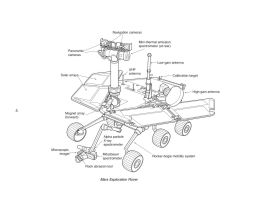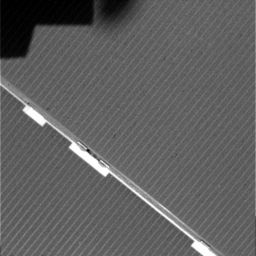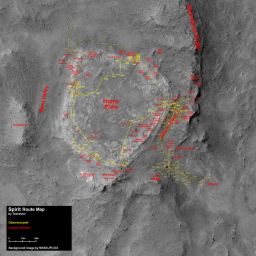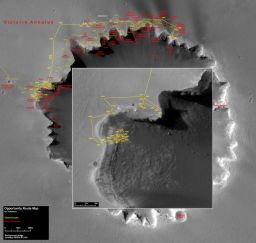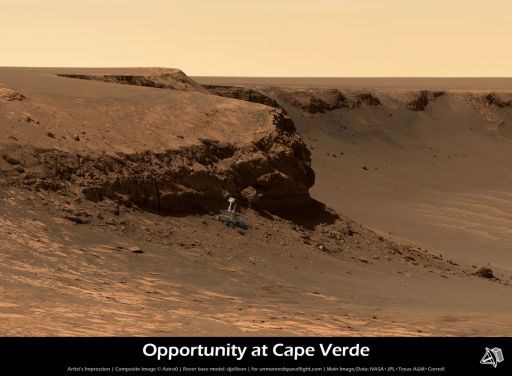A.J.S. Rayl • Apr 30, 2008
The Mars Exploration Rovers Update: Spirit Powers into Winter, Opportunity "Shoulders" Injury
With winter settling in on the southern hemisphere of the Red Planet, the Mars Exploration Rovers (MERs) spent April working on their respective science campaigns and hunkering down in brutally chilly nights that are seeing temperatures drop to around -95 degree Celsius. As the month comes to an end at Gusev Crater and Meridiani Planum, there is good news and there is bad news.
The good news is that Spirit's odds for survival seemed to improve significantly as the skies cleared dramatically over at Gusev Crater. Not only was the rover able to maintain better-than-anticipated power levels this past month, but the engineers "probably won't have to do anything extraordinary" to keep it alive, according to Jake Matijevic, chief of rover engineering.
"This is really significant," noted Steve Squyres, of Cornell University, the lead scientist for rover science, in an interview Monday.
Earlier projections were that Spirit would have to be put into a very low-power mode to make it through the winter, where heaters would be turned off to conserve power, much like they did with Opportunity last June-July during the global dust storm. But it was spring then.The beyond freezing temperatures of Martian winter nights and the thermal cycling -- the constant rising and falling of temperatures on Mars -- could break the scientific instruments, which, like the rovers, are more than four years past their three-month "warranties."
Still, "the latest power projections suggest we can probably get through the entire winter without disabling the Mini-TES survival heater," Squyres expounded. And that would insure the safety of the instrument that gives Spirit superhuman capabilities of "seeing" the composition of rocks and soil, at least from the winter cold.
Once again, Spirit has shown its mettle. It would seem to be enough to keep this rover in the spotlight for at least for a while. But, as usual, Opportunity roved in to command the attention, only this time it wasn't to upstage its twin with some grand achievement. That's the bad news. "The big issue," Squyres stated simply, "is what's going on with Opportunity's arm."
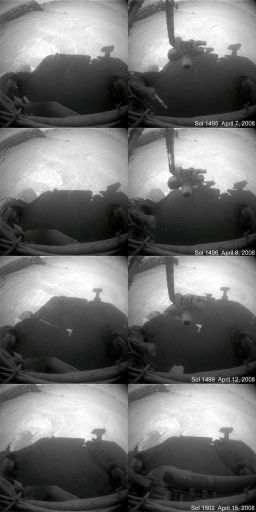 Unstow and "uh-oh" for Opportunity
Unstow and "uh-oh" for OpportunityAt the end of each day of driving, Opportunity unstows its robotic arm. This is a "workaround" procedure that was devised after the shoulder joint began stalling in November 2005. Since this rover must go into DeepSleep mode, shutting down all systems and heaters, because of a faulty heater, the team wanted insurance that the arm would always be available; therefore, engineers instituted a routine unstow at night, just in case a problem should develop in the cold of the Martian night. In mid-April, Opportunity unstowed its arm after a drive and its shoulder stuck. The rover was still awaiting its ground team's assessment at month's end.
Credit: NASA / JPL / montage by E. Lakdawalla
While Spirit was experiencing the clearest Martian skies either rover has seen on the mission, on the other side of the planet, at Meridiani Planum, Opportunity was under the "dark clouds" of aging, as its shoulder joint stalled, again. This time, Opportunity is facing the prospects that the motor that moves its shoulder from side to side is kaput – and that is going to change things for the glamorous, happy-go-lucky twin.
Opportunity roared out of March and into April on the road to Cape Verde. One of the "promontories" along the scalloped rim of Victoria Crater, Cape Verde features in its cliff face some of the most striking and distinctive stratigraphy or layering found on the MER mission, comparable to Burn's Cliff in Endurance Crater. Scientists and geologists in particular love layering in bedrock, because it separates and defines different geologic eras that once existed on Mars and can tell them a lot about what the planet was like during past millennia.
Although Opportunity was experiencing quite a bit of slipping as it navigated the inner slope of the crater, much of that came as a result of the rules of the road, so to speak, for driving inside the nearly 750-meter diameter crater. "The reason in part is because of a requirement we levied on the rover planners, which is that they do a kind of terrain assessment before we actually drive into a new area on the crater wall," explained Matijevic.
"Our general requirement is to drive in a little way, then pull back to demonstrate you can drive back from this position," he continued. "We have done that with every part of the driving since we entered the crater. That tells us that we have the ability to drive all the way back, retracing our tracks."
Two weeks ago, the drivers realized Opportunity had driven over a small ledge in the rock outcrop and into a softer, sandy terrain. "In an assessment, they realized this was actually a little bit of sand pit that had been obscured by a rock," said Matijevic. On April 14, the rover began its pullback and put four of its six wheels back on the bedrock path from which it came before calling it a sol. When it went to unstow its arm, as has been standard operating procedure for a couple of years now, it stalled in the first movement, just as it was swinging its shoulder out to the side. It brought the rover to a standstill.
The engineers quickly homed in on the small motor that controls the sideways motion -- the azimuth -- Joint 1 in the shoulder, which has been stalling occasionally for more than two years. The engineering team came up with a workaround, which involves applying increased voltage to overcome the problem. "But this [event] was different," said Squyres. It was a stall in Joint 1, but it usually happens when we're making tiny little motions and we work around it. This time it happened during an unstow event. We've never seen that before." And when the rover began the tired and true "workaround" of applying increased voltage on the following sol, the arm barely budged, if at all.
Rover engineers continue to troubleshoot the situation, but, said Matijevic, "[t]here is some possibility that we'll never be able to move this joint in the arm again."
The fat rover is a long way from singing though. In addition to figuring out it if the motor can be used again at all, the engineers are also assessing Opportunity's abilities to work if the motor is no longer usable.
"Even under the worst-case scenario for this motor, Opportunity still has the capability to do some contact science with the arm," said John Callas, project manager for the twin rovers at the Jet Propulsion Laboratory (JPL), where Spirit and Opportunity were designed and are being managed.
"What we've discovered -- and this is very good news -- is that even if the motor is gone we can still get the arm down on the ground," elaborated Squyres. "We're going to take our time and figure this out carefully because two-thirds of our payload is hanging off that arm and I really, really want to use the Mini-TES this spring out on the plains."
Perhaps even more importantly, Opportunity, which is sporting relatively energetic winter power levels around 370 watt-hours, will still be able to rove. For now, however, while the engineers do their thing, this rover is staying put. "We'll hold off backing out of the sand until after we've completed the diagnostic tests on the motor," Callas announced last week. "The rover is stable and safe in its current situation, and not under any urgency. So we will take the time to act cautiously."
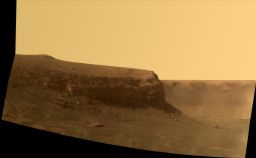 Cape Verde
Cape VerdeOpportunity took this image of Cape Verde on Sol 1487 (Mar. 30, 2008). This area was also imaged on Sol 1329 and on Sol 951, as part of the larger Duck Bay mosaic. Now that the rover is inside Victoria Crater, it is able to get a better look at promontories like this one, which provide tantalizing views under the surface into older materials excavated by the impact. The rover is currently in the process of driving to the base of Cape Verde to study the area with the instruments on its robotic arm. The overall soft quality of the image and the "haze" seen in the lower right portion are not dust in the local Martian atmosphere, according to Pancam lead scientist Jim Bell, but the result of scattered light in the camera optics from the dust on the front sapphire window. Credit: NASA /JPL-Caltech / Cornell
The process will take "as long as it takes" said Squyes. "Opportunity is warm, safe, has enough power and is doing well, keeping itself busy doing photometric observations and doing science."
The MER science team members are still looking forward to Opportunity roving in as close as it can get to the base of Cape Verde, another 15 to 20- meters ahead. "As we get closer, we'll continue to use remote sensing to make an assessment of the juiciest targets," said Jim Bell, lead scientist for the panoramic camera (Pancam) system and associate professor of astronomy at Cornell. "Once we get as close as we're going to be able to get, then the broad brush is to hit the cliff with everything we possibly can."
At Gusev Crater, Spirit stayed parked off the north end of Home Plate, as planned, for the entire month of April, collecting hundreds of the some 2,000 Pancam images that will go into its next winter panorama, named for legendary space artist Chelsey Bonestell, and keeping an eye on the dust. Each Pancam session requires about a half hour, which is a commitment for the rover these days. With winter taking hold and the Sun continuing its march to the north, it's starting to be slow going, because Spirit can average only about an hour to an hour and a half of science every sol it works. The prime directive now is "getting the whole winter campaign done as we make it through the winter," said Squyres.
"The challenge," added Bell, "is trying to get through the Bonestell pan as quickly as possible given the power constraints." The highest priority is getting the Home Plate segment done first. This view, looking back over the entire circular volcanic formation takes just a little under half the 360-degree field of view. So far, Spirit has been rising to the challenge, pressing on with its photographic assignment slowly, but steadily.
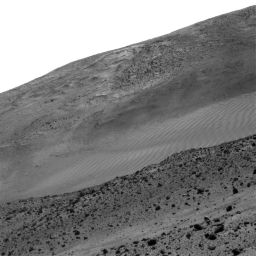 A slope with a view
A slope with a viewFrom its third winter locale, Spirit took this high resolution picture with its panoramic camera (Pancam) and sent it home in early April 2008. The rover's current parked position just off the northern edge of the circular volcanic formation called Home Plate gives it a choice view of the rippling El Dorado sand dunes in the near distance. Credit: NASA / JPL-Caltech / Cornell
Remarkably, Spirit has only lost 10 to 15 watt-hours of power during the last four weeks and is greeting May with levels around 237 watt-hours. "This is very good," noted Matijevic. "We had been expecting probably about 210 watt-hours based on one of the projections about three months ago that suggested this." Moreover, there has been no real change in the rover's status. "We generally are pretty pleased with Spirit's performance."
If it seems like this Martian winter has been dragging on and on, it's probably because the seasons there are about twice as long as they are on Earth for the simple reason that it takes Mars about twice as long to complete one orbit around the Sun as the Earth does. The Fall Equinox -- the start of fall, when night and day are equal in length -- arrived in Mars' southern hemisphere around December 12, 2007. Winter Solstice -- the time of year with the shortest day –occurs June 25, 2008.
During the next couple of months, both Spirit and Opportunity will endure extreme cold, "the coldest temperatures the vehicle will see at least for this winter," as Matijevic put it. The rovers are not actually taking external temperatures during the nighttime, but based on models created from data taken by the armada of spacecraft orbiting Mars the nighttime temperatures are predicted to be around -95 Celsius, he said. Where Spirit is, in Gusev Crater, though, there is more rock than soil, so temperatures are probably a little warmer than where Opportunity is at Meridiani Planum, because rocks absorb the heat of the day. Even so it's cold beyond our human comprehension.
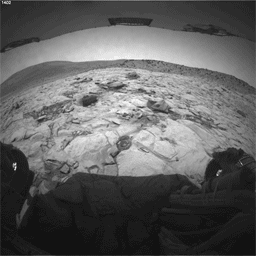 Spirit arrives at winter haven
Spirit arrives at winter havenHuman explorers would be hard pressed to show more persistence than Spirit. After weeks of careful driving backwards, dragging its broken front wheel, the rover made it to what team members call Home Plate North. It then gradually descended over the edge to get into position, as shown here, tilting its solar panels 13 degrees toward the sinking winter Sun to maximize its intake of light. Rover drivers continued nudging Spirit forward, increasing the tilt, to track the Sun as it moved lower in the northern sky. The rover is currently tiled at 29.9 degrees. The full-resolution version can be downloaded here (9.2 MB).
Credit: NASA / JPL-Caltech
"There's concern," admitted Bell. "And there's always going to be concern."
Spirit and Opportunity, however, remain healthy and -- with the exception of Opportunity's broken shoulder motor -- all other systems are performing as expected. While the outlook for Opportunity's shoulder "is not particularly encouraging," the engineers "can develop a different operational regime," assured Matijeivc.
The MER mission, from the outset, has been driven by the science, but at the get-go and especially during the last four post-primary-mission years there's been a whole lot of technological discovery going on, as Spirit and Opportunity continue to demonstrate their uncanny robotic resilience. "We learn every time," said Matijevic, "each period of our mission we've actually learned something about the performance of these rovers."
"They're doing remarkably well for having been on Mars for well over four years," smiled Squyres. "They're showing signs of age and it's becoming a very interesting challenge to operate them. The team has gotten very, very good at finding workarounds, ways of dealing with problems and we continue to get good productive science out of both vehicles long, long after I anticipated that they'd be done."
Although spring can't come soon enough, the MER team's commitment to the rovers is unwavering. "We feel very fortunate," Squyres said, "and we are still pushing them as hard as we can."
Spirit From Gusev Crater
As March gave way to April, Spirit was at work shooting the pictures for its next massive winter panorama, the full-color Bonestell Pan. Named for the revered science artist Chelsey Bonestell, this project will show the rover's 360-degree view from the north rim of Home Plate and requires the robot field geologist to take 27 columns of images, from foreground to sky. "These are full filter sets, taken at low compression levels, so it's a really high-quality dataset, analogous to the McMurdo pan we did with Spirit during the last winter," informed Jim Bell, the panoramic camera's (Pancam's) lead scientist. Most of the rover's science time in April would be devoted to the Bonestell Pan.
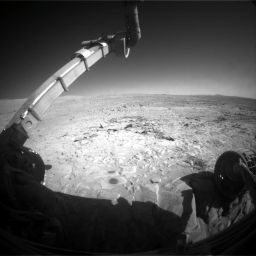 Hunkered down at Home
Hunkered down at HomeSpirit snapped this picture with its front hazard camera on Sol 1506 (Mar. 28, 2008). The rover is in the midst of a winter science campaign and will stay in this position until spring arrives in the southern hemisphere of Mars in late August, early September. Credit: NASA / JPL - Caltech
At the top of the month, Spirit was achieving power levels that fluctuated between 244 watt-hours and 256 watt-hours. The dust factor, however, remained nearly constant at 0.35. That means only 35% of the sunlight shining down is penetrating the dust layer and getting into the arrays to make electricity. Models generated three months or so ago predicted that Spirit would lose another 30 to 40 watt-hours of power in April. Then, something wonderful happened.
After acquiring a stack of microscopic imager (MI) pictures of a soil target dubbed Arthur C. Harmon, after the Tuskegee Airman, and using the alpha-particle X-ray spectrometer (APX) to check out its composition, on Sol 1510 (April 2, 2008), Spirit took some more images for the monster Bonestell Pan, and called it a day. The following Martian morning, it woke up to the clearest skies either of the two MERs have ever seen, with the amount of dust in the atmosphere or tau registering an all-time mission low of 0.127.
While a low dust factor is bad because it means the solar arrays are coated with a fair amount of dust, a low tau is good because it means the skies are fairly clear. As the month progressed, it all tallied to Spirit's benefit.
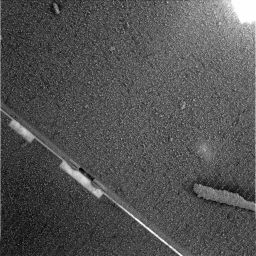 Got space age dust removal system?
Got space age dust removal system?The dust storm in June-July 2007, deposited a lot of dust on both Spirit and Opportunity. While Opportunity since experienced several gusts of winds that cleared its arrays, Spirit did not. As a result, Spirit's arrays are coated with dust. The Microscopic Imager picture above, which the rover recently sent home, shows just how dusty. Only about one-third of incoming sunlight is getting through to be converted to electricity. The only known and practical cleaning agent would be a timely gust of Martian wind.
Credit: NASA / JPL-Caltech / Cornell / USGS
Even so, the MER team kept to the plan of conserving energy by restricting communications, both in terms of the number of Martian days or sols on which Spirit receives direct-from-Earth instructions via its high-gain antenna and the sols on which it transmits data to Earth via the Mars Odyssey orbiter.
Spirit worked steadily, averaging 1 to 1.5 hours worth of science research every other sol, making progress on remote-sensing activities, as well as the Bonestell Panorama. Despite being on a reduced hours winter operations schedule, the rover packed in the research. In addition to monitoring atmospheric dust levels with the Pancam, checking for drift (changes with time) in the miniature thermal emission spectrometer (Mini-TES), and surveying the sky and ground with that instrument on a daily basis, the rover used the Pancam to acquire super-resolution images, specifically of a target named for the late, great Arthur C. Clarke target on Sol 1512 (April 4, 2008).
During the ensuing sols that first week of April, Spirit gathered more compositional data with the APXS from Arthur C. Harmon, pointed the APXS skyward to measure argon gas in the Martian atmosphere, acquired stability images of its nearly 30-degree tilt, collected more images for the Bonestell Pan, and monitored dust on the Pancam mast assembly.
As the second week of April dawned on Sol 1516 (April 8, 2008), the tau had increased to slightly to 0.170, but the skies over Gusev remained notably clear and Spirit continued to enjoy higher-than-expected energy levels for this time of year, with the solar array input translating to about 240 watt-hours per sol.
Despite the brutal nighttime temperatures at Gusev, Spirit continued taking the Bonestell Pan pictures throughout the week and also surveyed the horizon with the Pancam, shot movie frames in search of clouds with the navigation camera, acquired a stack of microscopic imager (MI) pictures of its solar array, surveyed its external calibration target with the Mini-TES, and with the hazard-avoidance cameras acquired lossless-compression images of wind-blown deposits next to it.
By the third week of the month, Spirit was ready for a break. It spent most of Sol 1523-24 (April 15-16, 2008) recharging its battery. In the sols that followed, the rover continued taking the Pancam pictures for the Bonestell Pan, as well as its daily dust monitoring and atmospheric observations, and even snuck in more remote sensing with the Pancam.
This week, Spirit launched again into its work on the Bonestell Pan and today is still boasting power levels of around 237 watt-hours of power. "We had been expecting probably about 210 watt-hours," said Jake Matijevic, chief of rover engineering at JPL. "One of the projections we had back about three months ago would have suggested this. Probably the most likely cause for the rover's present and surprising winter robustness, he said, is the lower tau conditions and a clearer atmosphere. "Since the sky is clearer, there is just not as much dust depositing. As a consequence of that, less dust fell on Spirit's solar panel."
Clear skies, however, can be something of a double-edged sword on Mars. "With clear skies, the temperatures will drop lower," explained Matijevic. That means the already bitter cold becomes colder. Hence, "we're getting a little bit more survival heat required for the vehicle," he said. Spirit is programmed to automatically turn on survival heaters for its rover electronics module (REM) once the temperature drops to around -40 Celsius. This, of course, insures the safety of the sensitive miniature thermal emission spectrometer (Mini-TES) and the other instruments housed in the REM, but heaters draw a lot of power from the vehicle.
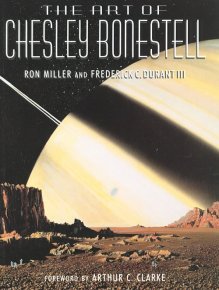 The Art of Chesley Bonestell
The Art of Chesley BonestellThis image shows the dust jacket cover of The Art of Chesley Bonestell by Ron Miller and Frederick C. Durantt III, published by Collins & Brown Ltd, 2001. Arthur C. Clarke, who wrote the forward for the book, defined Bonestell's impact as "colossal." Credit: Collins & Brown Ltd.
In order to prevent the REM heaters from automatically turning on, the engineers planned, if needed, to keep Spirit awake long enough each day to keep the REM sufficiently warm with heat from normal operations. That would not only keep the heaters from automatically turning on, but also provide a little more time for science observations. If that didn't work, they would have no real choice but to simply turn off the heaters, leaving the instruments vulnerable to the brutal cold and thermal cycling of the Martian winter.
"We were prepared to and expecting to have to [turn off the heaters]," said Squyres. "I do not know of course if disabling the heaters would kill Mini-TES. There's a good chance it wouldn't." Indeed, the Mini-TES on Opportunity -- which frequently shuts down all systems at night to go into a DeepSleep mode because of a heater that has been stuck in the "on" position since the beginning of the mission -- survived many frozen Martian winter nights, before being blasted with dust and put out of commission in the global dust storm last year. "But I'd rather not have to take that chance on Spirit," said Squyres. "And the numbers lately are looking positive enough that we think we might not even have to do that."
"The hope is that we can just continue that operation all the way through this Winter Solstice period," confirmed Matijevic. The new projections, in fact, are that Spirit will make it through without its crew on Earth taking any drastic measures. "We are 25 to 30 watt-hours better than our predicts were saying and that is all to the good," he added. "In all likelihood, we're not going to have to go into any unusual mode of operation on the vehicle. There are certain things we will do that are designed to protect us in case the situation changes somewhat abruptly. We are only getting data now every other day or every third day. In that sort of situation, we want to make sure the plans we give the vehicle are conservative enough so that it could tolerate changes in conditions. We're still kind of watching what's going on. There will be a few engineering configurations changes just to create this level of protection, otherwise we will continue to conduct our science campaign."
The MER team has never been one to count its robots before they hatch. "There are a lot of things that could change this picture -- if we suddenly see a higher tau, the atmosphere gets suddenly dustier, or if we get a higher than anticipated rate of build-up on the solar arrays," Squyres pointed out. "But if things continue to trend the way they have been, we suspect we can manage to squeeze our way through the whole winter without having to disable the heaters and I'm very, very pleased about that, because I really, really want to use Mini-TES when the spring comes."
For now, Spirit remains focused on its surroundings, capturing the images for Bonestell Panorama, a dataset analogous in high quality to the McMurdo Pan that Spirit collected last winter, the largest panorama taken so far on the MER mission.
Spirit's goal for Bonestell is a full 27 column x 3 tier panorama using 13 filters at each pointing. "That would be 1053 images, plus many hundreds of supporting --and much, much smaller -- images of the Pancam calibration target," informed Bell. "If we can achieve that goal, and if power, time, and data volume allow -- and Mars cooperates -- we would probably try to augment this coverage with additional coverage at lower elevation tiers on and just off the edge of the rover deck, like we did for the McMurdo pan last Martian winter in Gusev," he added. That could add several hundred more images, perhaps bringing the total, including calibration, to around 2,000 Pancam images.
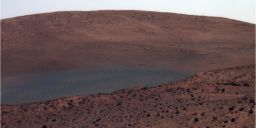 Looking northward
Looking northwardThis is the view that Spirit has looking northward from its position on the edge of Home Plate North, where the rover will spend its third Martian winter. Husband Hill is on the horizon. The dark area in the middle distance is the El Dorado sand dune field. The rover used its Pancam to capture this image during its Sol 1448 (Jan. 29, 2008.) It actually combines separate images taken through the Pancam filters centered on wavelengths of 753, 535 and 432 nanometers and is presented in a false-color stretch to bring out subtle color differences in the scene.
Credit: NASA /JPL-Caltech / Cornell
The highest priority for Spirit right now is to finish the Home Plate segment of the Bonestell Pan. That is the area behind or in front of the rover depending on how you look at it. Representing almost half the new winter panorama's field of view, the segment will clearly reveal the entire circular volcanic formation the rover has been studying for many months. "With Winter Solstice coming up, the temperatures and power levels are dropping, so we've been on this pace of just watching the frequency of being able to take these big chunks of the panorama decrease, but we're almost finished collecting the Home Plate segment," Bell said.
Given the limited communications sessions, the team is having to manage the data onboard Spirit, so the flash memory doesn't "freak out" the way it did way back in January 2004. "There is a lot of data onboard Spirit," said Bell. "It's not quite full, but it's up there. Most of the backlog still sitting onboard Spirit now is the Bonestell pan and it goes back to Sol 1480. Even though the frequency of communications is decreasing, the operations team at JPL team has been doing a great job of identifying the best, juiciest downlink passes they can find."
For most people, the pictures are like cool postcards from Mars -- and more than a few people have requested copies of the room-sized murals. For the scientists, however, they contain important data. "There are lots of debates about the origin of Home Plate," Bell pointed out, "and we can use the color and Pancam spectra to resolve variations across the structure and the relationship to the geology, among other things. "
As April turns to May, Spirit is around 40% of the way toward its goal for the Bonestell Panorama. The rover's total odometry remains at 7,528.07 meters (4.68 miles) and Spirit continues to experience clear skies and enough power to keep the MER team smiling.
Opportunity from Meridiani Planum
At the end of March, Opportunity was charged with crossing an inner slope of Victoria Crater to reach the base of Cape Verde, one of the "promontries" that juts out along the scalloped rim of the crater. There, the MER science team members plan to use the panoramic camera (Pancam) to take high-resolution pictures of the layering in the rocks, which is the best they've seen since Burn's Cliff in Endruance Crater. There's a story in the cliff's layers -- which define different geologic eras on Mars -- and the MER team hopes to read that story to better understand the past environments of Meridiani Planum.
There was no April fooling at Mars as Opportunity roved into the month driving 4.97 meters (16.3 feet) toward Cape Verde and acquiring the standard post-drive, navigation-camera images on Sol 1489 (April 1, 2008).
During the next couple of sols, the rover recharged its battery and took some Pancam images of Cape Verde to see the extent of the shadow caused by the position of the Sun in the sky and the cliff face. The shadows will ultimately determine how close Opportunity will be able to get to Cape Verde's base, because they hang around for much of the day and block the rover's access to the sunlight, the life fuel for a solar-powered rover.
Throughout the month, Opportunity continued with all the routine science tasks, including measuring atmospheric dust daily with the Pancam, occasional monitoring of the dust accumulation on its mast, and surveying the sky for clouds with the navigation camera, in addition to daily receiving morning instructions directly from Earth via its high-gain antenna, sending data back to Earth via the UHF antenna on the Mars Odyssey orbiter. As fate would have it, the rover also demonstrated this month the challenges of operating a vehicle on the surface of another, very harsh planet.
On Sol 1491 (April 3, 2008), Opportunity took some Pancam and navigation-camera images of a previously made wheel scuff, then stowed or tucked in its arm and set out again toward Cape Verde. The driving isn't anything like the driving Opportunity is used to out on the plains. This expedition along Victoria Crater's inner slope features slabs of broken bedrock and sandy stretches and it's been tricky. The rover is tilted sideways on the slope and some of the sandy patches are turning out to be a little more insidious that initially thought. Like most everything else on Mars, it all can be life-threatening to the rover. That's why the team is taking great care and the rover is following new rules of the road.
As a part of ensuring the rover's safety, the rovers planners have commanded Opportunity to stop and take a "toe dip'' before entering the sandy areas -- that is, drive forward a short distance and back out again. The toe-dip strategy provides valuable insight into the nature of the terrain the rover is likely to encounter on the way and ensures the rover will be able to backtrack and exit the same way it traversed into and around the slanting slope. The process has made for excruciatingly slow progress, but these are the new rules, written especially for driving inside this gigantic -- 750-meter diameter -- hole in the ground.
Actually, the rover planners at JPL have set very conservative limits on what Opportunity can do as it traverses this slope inside Victoria Crater -- and so far the rover hasn't balked. For example, if it exceeds the maximum amount of wheel slippage or the maximum amount of tilt allowed, it must abort the drive. This gives Opportunity's handlers a chance to further evaluate the situation and make changes to the drive plan on subsequent sols.
The limits, it turns out, are a good thing. While driving toward Cape Verde' base, Opportunity has experienced wheel slippage more than 90 percent and high tilts during backwards drives.
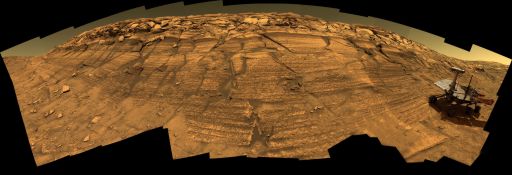 Burns Cliff Panorama (simulated)
Burns Cliff Panorama (simulated)In this version of the Burns Cliff panorama, a synthetic view of the rover was dropped in to the image. Opportunity scrambled slowly across the steeply sloped wall of Endurance Crater to reach Burns Cliff, a vertical pile of finely layered rocks that was irresistible to the rover sceintists. From this precarious position it captured a 7-color panorama from Sols 287 to 294 (Nov. 13 to 20, 2004). The bulging appearance of the wall is due to the rover's very close position to it. In reality, the view spans about 180 degrees and the wall is gently concave. The simulated rover model helps put the wall into perspective. For the full-resolution image, visit the Mars Exploration Rover website.
Credit: NASA / JPL / Cornell / D. Maas / Z. Gorjian / K. Kuramura / M. Stetson / E. DeJong
Beyond making slow but sure progress toward Cape Verde Opportunity rounded out the science in the first week of April by obtaining measurements of argon gas in the Martian atmosphere with the APXS and taking six movie frames in search of clouds with the navigation camera.
On Sol 1496 (April 8, 2008), Opportunity took spot images of the sky for calibration purposes with the Pancam and shot another four movie frames in search of clouds with the navigation camera, then stowed its arm and roved into the second week of the month, driving backward onto bedrock to extract its wheels from a sandy patch before proceeding once again toward Cape Verde. The following sol it took thumbnail images of the sky with the Pancam, shot another four movie frames in search of clouds with the navigation camera, then took a mosaic of images of the work volume reachable by the robotic arm with the Pancam, and some hazard avoidance pictures. When the evening Sun was low, the rover ended its sol with a Pancam sky survey.
Opportunity concentrated on its routine atmospheric observations on Sol 1498 (April 10, 2008), surveying the horizon and the sky, measuring dust in sky at sunset with the Pancam, and, after transmitting data to Odyssey, measuring argon in the atmosphere with the APXS. During the next two sols, Opportunity took more thumbnail images of the sky with the Pancam, shot another four movie frames of potential clouds with the navigation camera and drove closer toward Cape Verde.
Following a series of adjustments to both slippage and tilt limits after the Sol 1499 drive, the rover planners realized that Opportunity's front wheels had begun to dig a little bit too much into the sandy terrain and decided at that point to have the rover concentrate on driving backward to extract its front wheels and prevent them from digging further into the soft patch. The next sol, April 13, 2008, as planners reviewed the status data, the Opportunity acquired a full-color panel of Pancam images of Cape Verde and quietly celebrated another the milestone -- 1500 sols or Martian days of continuous exploration, then rested and recharged its battery.
Then, on Sol 1501 (April 14, 2008), Opportunity initiated the commands to back out of the sandy patch. It drove backward 24 centimeters (9.5 inches) with no errors, placing four of its six wheels back on bedrock and giving rover drivers hope that the golf-cart-sized robot field geologist would soon be out of the sand. As usual, the commands included unstowing the arm at the end of the day's short drive. The shoulder motor began the unstow, moving the shoulder partially to the side – and then it stalled and the Opportunity's arm froze in place.
After surveying the horizon with the Pancam in the morning on Sol 1503, Opportunity acquired MI pictures of its arm to document changes during the diagnostic test of the rover appendage. The engineers at JPL, meanwhile, zeroed in on the motor that controls the azimuth or side to side motion in Joint 1 of the shoulder. A turret at the end of the arm has four tools that the arm places in contact with rocks and soils to study their composition and texture. Other motors in the arm -- also called the instrument deployment device (IDD) -- provide up-and-down motion at the shoulder and maneuverability at the elbow and wrist.
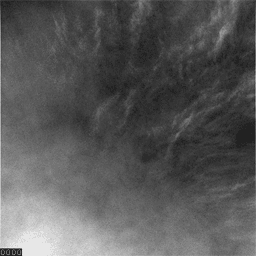 Clouds over Victoria
Clouds over VictoriaOpportunity turned its rover eyes skyward to observe clouds drifting overhead in March, much like it has throughout the mission. The clouds it captured here passing over Victoria Crater look like cirrus clouds on Earth, featherlike formations composed mostly of ice crystals.Credit: NASA / JPL-Caltech / Cornell / ASU / Texas A&M / Navigation camera
"We've seen stalls in this joint many times before," Squyres said. "They almost always occur when we do delicate little motions and they're due to a broken wire and we know how to work around it. But this time was different. The nature of this stall was different."
Opportunity's balky shoulder motor began stalling occasionally in November 2005. The MER team devised a "workaround" of applying increased voltage and the motor has been used effectively ever since. The engineers did assess then, however, that the arm had an increased likelihood of becoming unusable. Motion of the stall-prone shoulder motor is necessary, however, to unstow the arm, so if the motor were to die with the arm in the stowed position, the arm could not be deployed again. With diminished confidence in the balky motor, the JPL rover engineers changed the rover's standard procedures for stowing and unstowing the arm and for two years now Opportunity has been implementing a Stow/Go/Unstow strategy.
Because the rover has a heater that is stuck in the "on" position drawing continuous power, Opportunity must often be put into DeepSleep mode at night, where all systems, including the heaters, are shut down. The cold, cold temperatures could induce a motor failure in the arm. As long as the arm is unstowed overnight, however, it will still be available for full use of its scientific tools even if the motor dies. So, after each drive, the rover unstows its arm to avoid having it stowed during thermal cycling of temperatures ranging from 0 to -95 degrees Celsius and the beyond-freezing temperatures overnight. On days when the arm is not used, the rover has ben keeping it resting on a hook under the front of its deck.
"There are many possible things that could cause this stall," said Squyres. "There are many things involved in moving a motor on the vehicle. You've got the motor controller board inside the rover, the cable that runs up the arm, the motor itself, the gearbox associated with it, etcetera, and the data were not clearly consistent with only one possible event having taken place. What you want to do is methodically work your way through what you might call a fault tree, sort of lobbing branches off one by one until you've eliminated possibilities and find the problem." And that's exactly what the MER team has been doing.
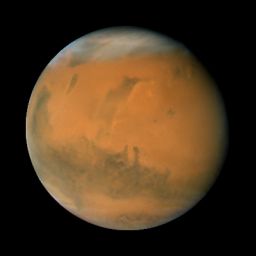 Mars during the 2007 opposition
Mars during the 2007 oppositionThe Hubble Space Telescope took this photo of Mars during its 2007 opposition, when it was about 90 million kilometers from Earth. This view was captured on Dec. 7, 2007 and is centered at a longitude of about 140 degrees. Credit: NASA, ESA, the Hubble Heritage Team (STScI/AURA), J. Bell (Cornell University), and M. Wolff (Space Science Institute, Boulder)
A check of the motor controller board that drives the motor was simple enough. The way the rover is configured, the same motor that drives Joint 1 in the shoulder also drives the right front wheel. "We multi-flexed it, because there's not reason not to -- you're never going to use the wheel and the IDD at the same time," Squyres explained. To "exonerate" the motor controller, the engineers rotated the right front wheel to make sure it worked properly. "It did," he confirmed. "That means it's not the drive electronics. We've eliminated a bunch of possibilities and have a few possibilities left and we're in the process of working it out. But we're going to take our time with this and do this carefully."
As the troubleshooting and diagnostic process continued, Opportunity was assigned a variety of scientific tasks from its position midway to the base of Cape Verde. On Sol 1504 (April 17, 2008), for example, the rover acquired full-color Pancam images of trenches dubbed Williams and Harland, which it had created with its wheels, and took some routine thumbnail images of the sky with the Pancam. After relaying data to Odyssey, the rover pointed the APXS to the sky and began taking the usual measurements of the argon gas in the atmosphere.
The performance of the motor proved consistent with increased resistance in the electrical circuit, probably caused by the degrading of wire in the winding, rather than a mechanical jam, according to an official JPL report. Additional tests were continued to see if the apparent resistance is localized or intermittent. "In the past week and week and a half, we have been doing rehearsals of engineering tests on the vehicle we have here on Earth and engineering tests on the vehicle at Mars," Matijevic informed. "Probably in the first set of tests we did, it seemed to be a change in motor characteristics that causes us to feel like we're probably not going to be able to move that joint very much in the future." As a result, the engineers also began doing "a little bit of prototyping of certain kinds of operations with the arm in its present configuration," including driving.
Meanwhile, Opportunity has not moved. "We still have four wheels on this ledge and the front two wheels are down into this little bit of sand below the ledge," Matijevic confirmed. That puts the rover about 15 meters from the spot where the team planned for it to make its approach, Matijevic added, and probably another 5 meters from the closest spot it could be.
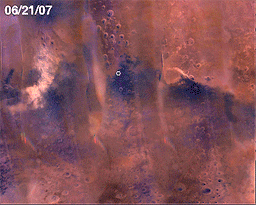 Storm crossing
Storm crossingThis animation -- the handiwork of Glen J. Nagle, the education & outreach manager of the Canberra Deep Space Communication Complex in NASA's Deep Space Network -- is made from images taken by Michael Malin's Mars Color Imager (MARCI) camera onboard the Mars Reconnaissance Orbiter. it shows how the storm moved in on and over Opportunity at Meridiani Planum from late June through mid-July, 2007.Credit: NASA / JPL-Caltech / MSSS / animation by G.J. Nagle
"We're still hoping to get to Cape Verde, but we've got to work out our arm situation first," Squyres said. "The intention -- to get as close as we safely can and take super resolution imaging and whether or not we do any IDD work or not -- depends on how this troubleshooting goes and we're still in that process," he added.
In any case, the way Opportunity will approach the task at Cape Verde has changed. "We always anticipated getting to a kind of staging area for the Cape Verde campaign and starting some of our imaging at that point, then, if it looked as though it was possible, drive a little closer to get some real close-up images and do some IDD work in the near vicinity," recounted Matijevic. "I don't think we're going to end up doing that. Some of it was ruled out anyway, because at this time of year, the areas we thought we could reach without putting the rover through severe conditions are now looking to be a little more challenging or dangerous for the vehicle.
For one thing, the whole Cape Verde base area is actually in shade toward the afternoon, he pointed out, which is not good from the vehicle's power generation perspective. "We've been taking images of the areas during different times of day and you can kind of see the extent of the shadows and it looks now like we will probably have to maintain a standoff distance of at least 5 meters.
As grand as the stratigraphy is at Cape Verde, Opportunity won't be hanging around waiting for the spring to come, the Sun to rise higher in the sky, and the shade to recede. That would take at least another six months, estimated Matijevic, and this team is far to anxious to keep these rovers roving.
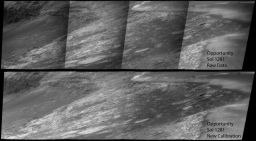 Doggone dust
Doggone dustThe panoramic cameras (Pancams) on Opportunity took on some dust during the storms that beseiged the rover in June and July 2007. The top panel, courtesy Jim Bell and colleagues at Cornell University, shows four frames from a Sol 1281 (Sep. 1, 2007) panorama of the inner wall of Victoria Crater, near Duck Bay. These are raw images using the left eye 753 nanometer ("L2") filter. Notice the significant darkening of the right side of each image that causes large, ugly seams in the resulting mosaic. "We believe that that darkening is caused by dust that accumulated during the 2007 global storm and may be in front of the Pancam's front sapphire window, which is recessed within a small sunshade on the front of each camera," Bell said. Luckily, the Pancam team's calibration pipeline is "flexible" they were able to acquire some new "flatfield" images recently to try to correct for this darkening. The team's efforts at getting rid of the darkening, shown in the lower panel in this image and based on work primarily being done by Pancam software maven Jonathan Joseph at Cornell, has improved even more in recent months.
Credit: NASA /JPL-Caltech / Cornell
Most of the science at Cape Verde will likely be done with the Pancam and full-color close-ups and super resolution image are at the top of the agenda. The team is studying the super-res images the rover took of Cape Verde last year for direction and guidance. "We're trying to use the color information to identify the talus or scree that blocks and rubble that has fallen down," explained Bell. "We're trying to use the color information ahead of time, so that we can identify what parts of that rubbley slope are different from each other and whether there is any relationship between pieces of rock and debris we see on the ground and that we can get to with the rover and the cliff faces where we can't get to."
The Pancam team is still grappling with all the dust on the front lens of the stereo camera system. In those images taken late last year, it looks like the crater is full of fog. "But it's from the dust on the lens, not dust or fog in the atmosphere," confirmed Bell. "The dust storm [in June, July 2007] contaminated Opportunity's Pancam lenses quite a bit. We've done the best we can so far to correct for it, and we continue to develop new methods. We still look at the sky occasionally to try and characterize the dust on the windows and we are getting better at it with time. Still, it's challenging, because you're actually blocking some of the light and there's only so much correction you can do to get it back since you are looking through this dusty window. It's almost like you're viewing the world with one of those fuzzy filters that photographers use to give the world a dreamy look." While Hollywood loves the soft focus, because it take the wrinkles out, "in Opportunity's case, on Mars, we want the wrinkles," Bell said.
Once Opportunity gets within good, close-up shooting distance, "we'll do as much as we possibly can do," said Bell. "We'll certainly do multi-spectra and try to get the highest resolution in the layering on the cliff, including super-resolution."
"But we do have to sort of get there," Matijevic reminded. "I think what's true is that we're not going to be able to move the joint enough to actually fully stow the arm. So now the problem becomes a driving challenge, in terms of the clearance envelopes for the vehicle given the arm in this configuration, and the second has to do with what forces you put into the arm that might possibly move the arm from its current location. The danger there is not so much that the arm could wobble and return to its current position, but that you put in forces that might cause the actuators to backdrive a bit. When you do that, because we're not actually actuating the arm while we're trying to drive, you've created uncertainties in terms of what your knowledge is of the locations of the joints. That propagates into the next time you try to use the arm," he explained.
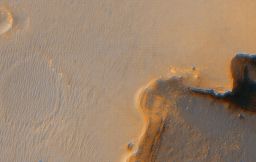 Opportunity at Cape Verde
Opportunity at Cape VerdeThis image from the High Resolution Imaging Science Experiment (HiRISE) on NASA's Mars Reconnaissance Orbiter shows Opportunity near the rim of Victoria Crater, an impact crater about 750 meters (half-mile) in diameter at Meridiani Planum. Five days before this image was taken in Sep. 2006, Opportunity arrived at the rim of Victoria, after a drive of more than 9 kilometers (more than 5 miles). It then drove to the position where it is seen in this image. Shown in the image are Duck Bay, the eroded segment of the crater rim where Opportunity first arrived at the crater; Cabo Frio, a sharp promontory to the south of Duck Bay; and Cape Verde, the promontory to the north and to which the rover is now headed from the inside of the crater. When viewed at the highest resolution, this image shows the rover itself, wheel tracks in the soil behind it, and the rover's shadow, including the shadow of the camera mast.
Credit: NASA / JPL / University of Arizona
Another thing, which does not affect driving so much, but does affect any further operation of the IDD, is, Matijevic said, that there is "going to be increased difficulty and some uncertainty in the placement of instruments." That, in turn, will limit in some respects the kinds of targets the rover can work with and add additional uncertainty in terms of where the rover is actually taking measurements on the target."
Whatever the ultimate diagnosis of the motor in Joint 1 in Opportunity's shoulder is, one thing seems certain. As Matijevic put it: "It's going to represent something of a different operational regime for the vehicle from that point on."
It's enough of a challenge that it might stop another rover and another team. But MER? Not on anyone's or any robot's life.
"Even if we lose this joint, Opportunity's elbow has deployed out enough that we can deploy the arm down onto the ground and can still do science down on the surface," Squyres said. "We believe we can [drive] as well. It's not the perfect position for doing either of those, but we do believe we can both drive and do science with the IDD even if we never move this joint again."
As of Sol 1517 (April 30, 2008), other than its injured arm, Opportunity remained in good health with a total odometry of 11,691.49 meters (7.26 miles).
The Time is Now.
As a Planetary Defender, you’re part of our mission to decrease the risk of Earth being hit by an asteroid or comet.
Donate Today

 Explore Worlds
Explore Worlds Find Life
Find Life Defend Earth
Defend Earth



